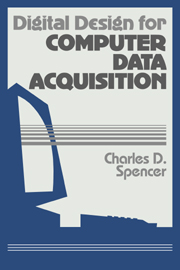Book contents
- Frontmatter
- Contents
- Preface
- 1 Computer Measurement
- 2 Introduction to Digital Electronics
- 3 Parallel I/O Ports
- 4 Tutorial on the AD573 ADC
- 5 Tutorial on the 6264 RAM
- 6 Tutorial on the Intel 8253 PIT
- 7 Control/Data Interface
- 8 ADC Module
- 9 Comprehensive Measurement System
- 10 Fast Voltage Measurer
- Appendix A References
- Appendix B Vendors
- Appendix C IC Pin Assignments
- Appendix D IBM Paralel Ports
- Appendix E Apple II Parallel Ports
- Appendix F Computer Architecture
- Index
2 - Introduction to Digital Electronics
Published online by Cambridge University Press: 10 November 2009
- Frontmatter
- Contents
- Preface
- 1 Computer Measurement
- 2 Introduction to Digital Electronics
- 3 Parallel I/O Ports
- 4 Tutorial on the AD573 ADC
- 5 Tutorial on the 6264 RAM
- 6 Tutorial on the Intel 8253 PIT
- 7 Control/Data Interface
- 8 ADC Module
- 9 Comprehensive Measurement System
- 10 Fast Voltage Measurer
- Appendix A References
- Appendix B Vendors
- Appendix C IC Pin Assignments
- Appendix D IBM Paralel Ports
- Appendix E Apple II Parallel Ports
- Appendix F Computer Architecture
- Index
Summary
Modern Integrated Circuits (IC's) have changed the effort and skills required to design and construct systems which carry out sophisticated digital operations. While it's desirable to understand how IC's work in terms of semiconductor physics and while good engineering practices are necessary in commercial products, it's now possible to successfully put together data acquisition hardware without first mastering these subjects.
Only fifteen different IC's are required for the parallel ports circuits of Chapter 3, for the analog-to-digital converter, memory and programmable interval counter circuits of Chapters 4-6, and for the measurement systems of Chapters 7-10. The purpose of this chapter is to introduce these and a few other IC's as well as associated design principles. Section 2.1 covers basic logic gates. Section 2.2 introduces integrated circuits, breadboarding and troubleshooting. Section 2.3 presents digital clocks. Section 2.4 introduces the 7474 flip-flop and a variety of timing and control operations. Section 2.5 outlines electrical properties of logic gates. Section 2.6 presents binary, hexadecimal and decimal number systems. Section 2.7 covers the 74192 and 74193 counters and several applications. Section 2.8 presents the 74138 decoder/demultiplexer and additional control applications. Section 2.9 introduces the 74152 multiplexer. And Section 2.10 presents tri-state gates, buses and the 74373 and 74244 buffers. While these topics provide a complete background for this book, readers are referred to Appendix A for more comprehensive introductions to digital electronics.
In general, a logic gate may be thought of as shown in Figure 2.1. It has one or more inputs and one or more outputs, and requires +5 volts and ground. The inputs must be in one of two states (+ 5 volts or zero volts).
- Type
- Chapter
- Information
- Digital Design for Computer Data Acquisition , pp. 4 - 51Publisher: Cambridge University PressPrint publication year: 1990



